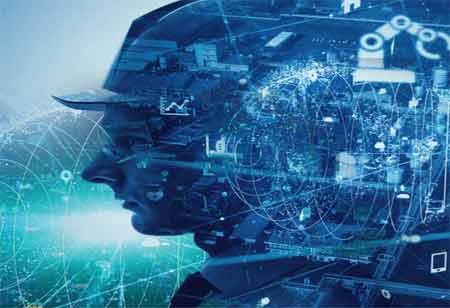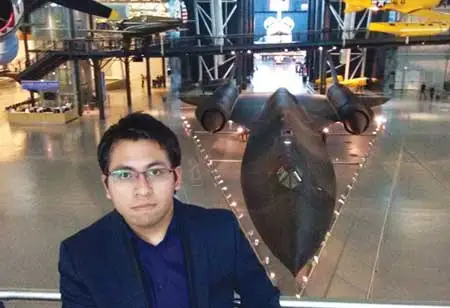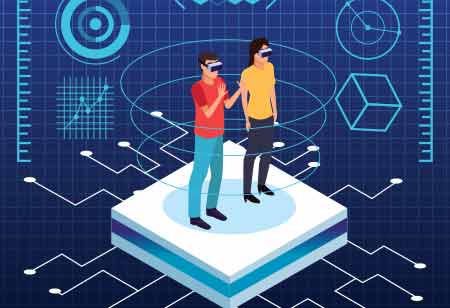THANK YOU FOR SUBSCRIBING

An Operator Walks Up To A Machine Tool
Paul Guerrier, Manufacturing Engineering Manager, Moog Inc.

 Paul Guerrier, Manufacturing Engineering Manager, Moog Inc.
Paul Guerrier, Manufacturing Engineering Manager, Moog Inc.Perhaps one of my favorite jokes is “A horse walks into a bar,” pause for dramatic effect, “Why the long face?”
It is a great joke for so many reasons, coworker-friendly and kid-friendly being chief among them.
A few months ago, I heard a vision of the future that reminded me of this joke. In this vision, “An Operator Walks up to a Machine Tool…” Once at the equipment interface, they then start to have a conversation with the equipment about today’s schedule, how the current job for Customer X is going, if any G-code changes might be needed, how all of the 100 cutting tools are doing, and other work-related topics. At first, I frankly didn’t see the vision. Amazon’s Alexa is neat, but fairly often, you find yourself pretty frustrated, shouting at the device, wondering why it refuses to play the specific podcast/music you requested or, in a worse case, ordering something online for which you have no need.
"From within the aerospace industry, there is a strong desire to improve: for years, organizations have been working to lay out their visions to achieve “zero defects"
More recently, we started to investigate the benefits of Generative AI here at Moog Inc. It turns out that I now consider my initial reaction to be wrong (and, yes, just like everyone else, I am still getting used to the feeling). My understanding of the relevant technology, as well as the likely timescale, was incorrect. As I started to work with Generative AI here at Moog, I also started to read and watch blog posts, articles, and breathless YouTube videos. A great multitude of information was a few clicks away.
Based on experiences at Moog so far, using gigantic neural networks hosted on a cloud server to help with everyday manufacturing tasks really does seem within reach. As an example, you can ask (prompt) many of the currently available tools to create G-code for a simple geometry and receive a response. You can also ask (prompt) to understand G-code that you are unfamiliar with and receive a response. You can upload a section of computer code, like Python, and ask (prompt) for an optimization or comments to be added. A few seconds later, the response is returned. It is also possible to “have a conversation with a document” via a method named retrieval augmented generation (RAG). You ask natural language questions and get responses that are based on the document that you loaded. This is very different from a find or a keyword search.
Neat stuff for sure, but why was I wrong on the timescale? The reasons, in approximate order of importance, are below.
• Already built infrastructure
• Capital investment
• A strong desire within aerospace to improve
• Workforce change
Thanks to the internet, personal computing, and mobile computing, networking and computational resources are currently available. While we are likely to need more, the basics are already in place. As with most technological changes, it will be expensive. But capital investment is in place, and startups working hard to make a dent are currently plentiful.
From within the aerospace industry, there is a strong desire to improve: for years, organizations have been working to lay out their visions to achieve “zero defects.” To clarify, this is quite different from safety, which is typically designed into system architecture (duplex, triplex, and even quadruplex are common) or system testing, such as simulated flight hours for pilots. The idea of “zero manufacturing defects” might seem like an impossible task, but with the use of AI, it could be more achievable than ever. While it is unlikely that AI will eliminate all unexpected problems, for the problems that remain, an AI assistant will be available to help evaluate large amounts of data or to help determine a root cause, even with sparse or disparate data. This will help identify and/or solve challenging production problems earlier, reducing time and cost while improving outcomes on the road to “zero defects.”
Finally, the driving force for the accelerated AI timescale is the workers using it. As AI continues to advance, new workers are going to expect it to be integrated into their work, training, and process improvement. When joining a new industry, wouldn’t you take help to keep up with your more experienced and knowledgeable colleagues in order to contribute? Additionally, for “dyed in the wool” veterans of many aerospace programs, adoption will have a different complexion. This group is likely to be happy to have fewer mundane tasks that they can hand off to AI. It will need to be intuitive and clearly better than existing tools; otherwise, the need for change will not be felt. Another benefit that this group is likely to experience is new abilities that they would not have without AI. In the same way that new members of the workforce will be able to get up to speed faster, more experienced folk will also be able to change roles more easily, taking the soft skills that they have developed over many years of work.
So, if all that I have described is realistic, why is the operator still featured in this scenario? There are several solid reasons. First, AI has an error rate associated with its output, probably between 40% for a task that it has been trained for but does badly and 1% for a task that it does really well. For decisions where getting it right matters, such as manufacturing high-quality aerospace products and solutions, a human operator will have to remain “in the loop” for the foreseeable future. Secondly, AI has no “intention,” meaning that it doesn’t want to do/be anything and has no hopes or dreams. At its root, AI is simply complex math that processes inputs to produce an output. (AI might be better named Applied Statistics: less dramatic but closer to the reality of what is happening.) In short, AI is a “power tool” and needs an operator to direct it.
So, my beliefs have changed, and in a shortish period of time, I expect to see “An inexperienced operator walk up to a machine tool and, working together with AI, has a productive shift making important aerospace components.”
Read Also





















ON THE DECK